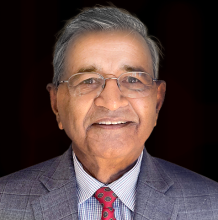Lessons from Nature: Bioinspired Mechanically Durable and Self-healing Superliquiphilic/phobic Surfaces

Dr. Bharat Bhushan
Academy Professor
The Ohio State University
Thu, 11/14/2024
Abstract: Living nature, through some 3 billion years of evolution, has developed materials, objects, and processes that function from the nanoscale to the macroscale. The understanding of the functions provided by species and processes found in living nature can guide us to design and produce bioinspired surfaces for various applications1,2,3. There are a large number of flora and fauna with properties of commercial interest. A facile, substrate-independent, multilayered nanoparticle/binder composite coating technique has been developed to produce various combinations of water and oil repellency and affinity with self-cleaning properties. These coatings provide the basis to fabricate surfaces for a range of applications including self-cleaning, anti-fouling, anti-smudge, optical transparency, anti-fogging, anti-icing, low drag, water purification, and oil–water separation.
- 1Bhushan, B., Biomimetics: Bioinspired Hierarchical-Structured Surfaces for Green Science and Technology, third ed., Springer (2018).
- 2Bhushan, B., Introduction to Biomimetics and Bioinspiration: Materials and Surfaces for Green Science and Technology, Springer (2024).
- 3TED Talk - Lessons from Nature: Bioinspired Surfaces for Green Tech, 2019
Bio: Dr. Bharat Bhushan is an Academy Professor (San Jose, CA), and has served as Ohio Eminent Scholar and Howard D. Winbigler Professor, and Director of Nanoprobe Laboratory for Bio- & Nanotechnology and Biomimetics at Ohio State University, Columbus, Ohio. He holds B. S., two M.S., a Ph.D. in mechanical engineering, MBA, and five honorary doctorates, a total of 10 College degrees. His research interests include Fundamental studies in the interdisciplinary areas of Bio/nanotribology/nanomechanics, Nanomaterials Characterization, Scanning Probe Techniques, Magnetic Storage, Bio/nanotechnology, Nanomanufacturing, Bioinspired Liquid Repellency, Self-cleaning, Anti-icing, Anti-fouling, and Water Harvesting, Science and Technology Policy. He has authored 10 books and 900+ papers and holds 25 US and foreign patents. He has previously worked for Mechanical Technology Inc., SKF, and IBM Almaden Research Center, San Jose, CA.
He is the recipient of numerous awards and international fellowships and a member of International Academy of Engineering (Russia). He has previously worked for various industrial research labs including Mechanical Technology Inc., SKF, and IBM Almaden Research Center, San Jose, CA.
Socially-Aware Navigation for Robots in Public Spaces

Dr. Roya Salek Shahrezaie
Assistant Professor
CS Department, Sonoma State University
Thu, 11/07/2024
Absract: As robots become increasingly integrated into public spaces such as hospitals, shopping malls, airports, and museums, their ability to navigate intelligently and socially is crucial. Socially-aware navigation (SAN) goes beyond simply moving from one point to another; it involves understanding and respecting human social norms to ensure that robots’ interactions are comfortable and non-intrusive.
A key aspect of SAN is the robot's ability to detect and respond to the context of its environment. In this work, we propose a novel method for context detection that allows robots to accurately interpret their surroundings and adjust their behavior accordingly. By understanding social cues and the dynamics of the environment, robots can navigate in a way that maintains personal space and fosters a sense of safety and comfort for the people around them.
Additionally, we developed an innovative architecture for SAN in which the robot dynamically executes social navigation behaviors based on the detected context. This system enables robots to seamlessly adapt to diverse social settings, ensuring their presence is perceived as natural and non-disruptive. With this enhanced level of social intelligence, robots can integrate more effectively into public environments and contribute more meaningfully to the spaces they inhabit.
Bio: Roya Salek Shahrezaie is a new Assistant Professor in the Department of Computer Science at Sonoma State University. She earned her Ph.D. in Computer Science and Engineering from the University of Nevada, Reno, where her research centered on human-robot interaction, particularly in the context of socially aware navigation for robots in public spaces. She also holds a Master’s and a Bachelor’s in Computer Science. Before her doctoral studies, Roya gained valuable industry experience as a developer and systems engineer.
Designing a Bandpass Filter with Network Synthesis

Dr. Robert Lee Bruce
Retired
Thu, 10/17/2024
Abstract: This presentation shows the steps to design a bandpass filter starting with a specification of the passband, then to derive a prototype lowpass filter using network synthesis, and fimally to convert to a bandpass filter.
Bio: Dr. Robert Lee Bruce received his BSEE degree from San Diego State College in 1963. He received his MS degree from Leland Stanford Junior University in 1965 and continued there to receive his PhD in 1969. He has worked in industry in the areas of telecom, lightwave, fare collection, offshore location, and electronic distance measurement. He has 4 patents and 7 publications.
RF & Microwave Engineering: Perspectives of a Hardware Engineer

Ms. Chelsi Wieland
Lead R&D Microwave Hardware Engineer
Keysight Technologies, Santa Rosa, CA
Thu, 10/03/2024
Abstract: Hardware engineering is a critical to designing and manufacturing successful high frequency systems and presents unique and complex challenges. This presentation will discuss what delineates RF, microwave, and high frequency engineering as a specialization and describe some design and testing methodologies useful in application. Additionally, some basic simulations and troubleshooting stories will be shared and the role of a hardware engineering lead discussed.”
Bio: Chelsi Wieland earned B.S. degrees in Electrical Engineering and Physics and finished a Master in Electrical Engineering from Kansas State University, specializing in RF, microwave, and integrated circuit design, in 2012. Chelsi has worked in a variety of application spaces as a hardware engineer, from COTS based PCBs in densely integrated analog and digital platforms, to CMOS integrated circuit design. Chelsi began working for Keysight 2022 as project lead and a technical contributor. She transitioned quickly to research and development specializing in high frequency and microwave and is currently working as a hardware technical lead on next generation systems at Keysight.
The Coming 6th Generation of Mobile Wireless (Fall 2024)

Mr. Roger Nickols
6G Program Manager
Keysight Technologies, Santa Rosa, CA
Thu, 09/19/2024
Abstract: The first commercial 5G deployments were in March of 2019—barely three years ago and the path to 6G is already a few years under way. It is without a doubt that 6G will be evolution and revolution beyond 5G, but some of the differences are already quite clear. Not only is the technology going to be different, the change in commercial and government approach to commercial wireless systems has already begun. This talk will cover what remains to be realized from the original 5G vision and what to expect from the work on 6G during the next decade.
Bio: Mr. Roger Nichols is an acknowledged subject matter expert in mobile wireless communications design and measurement technologies. He has 37 years of engineering and management experience at Hewlett-Packard, Agilent, and Keysight Technologies spanning roles in R&D, marketing, and manufacturing. He has managed projects, programs, and departments beginning with analog cellular radio evolving to 6G and on every standard in between. He directed Keysight’s 5G program starting in 2014 and has been directing Keysight’s 6G program since its inception in 2019. He is a member of the FCC Technical Advisory Council and is also the strategic director of Keysight’s work in wireless standards. Roger holds a BSEE from the University of Colorado, Boulder.